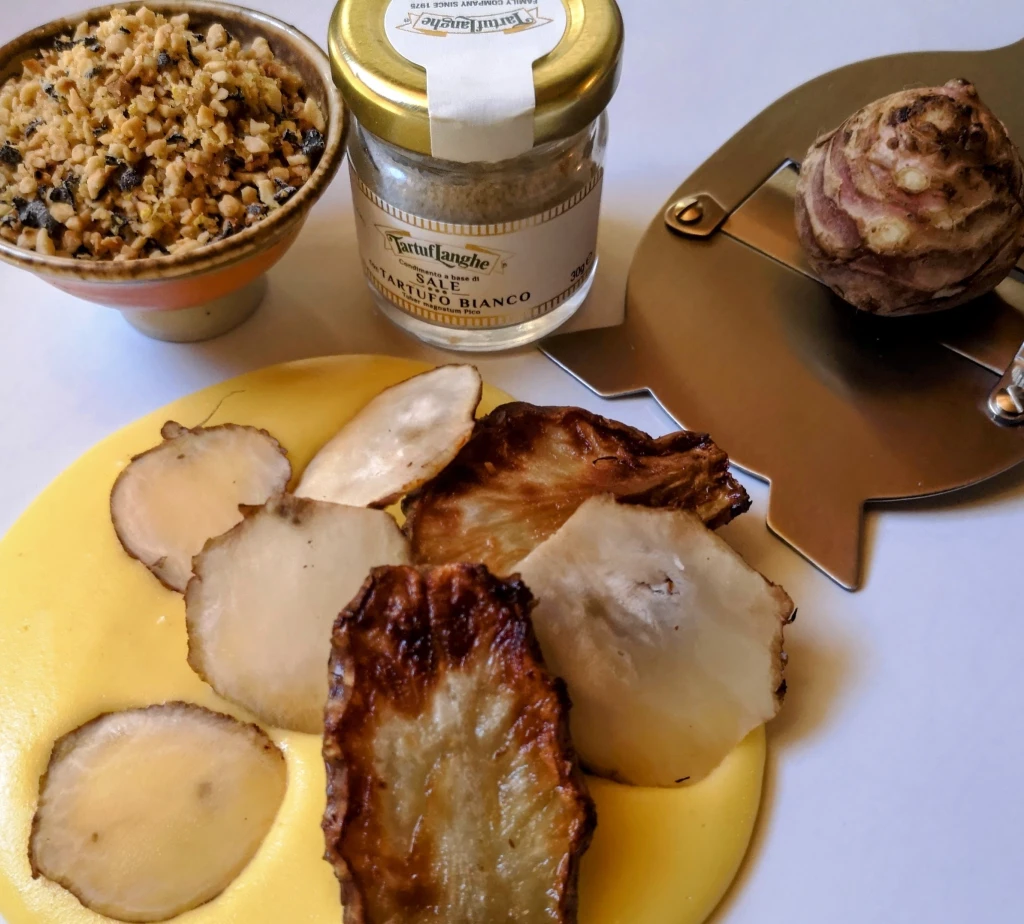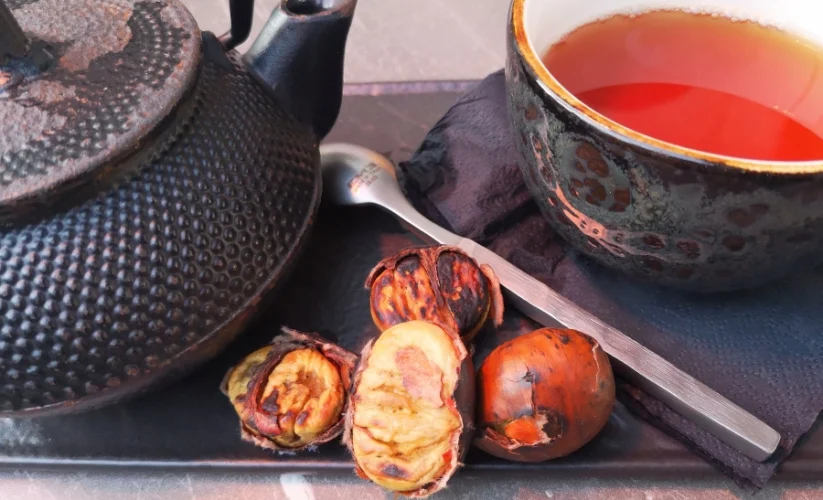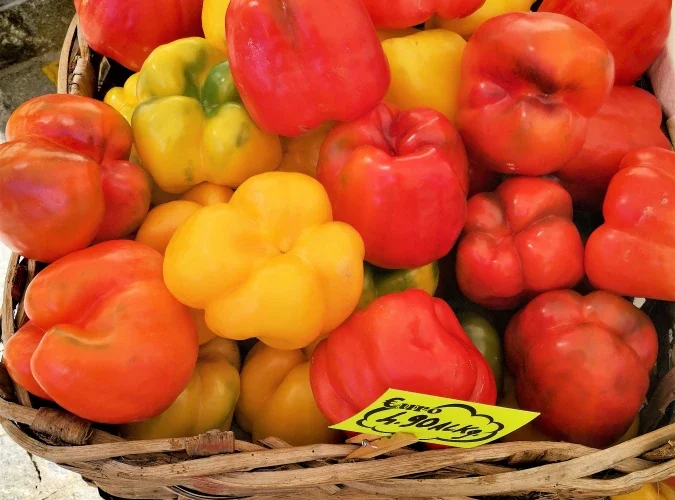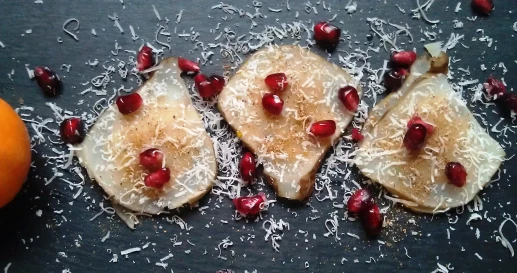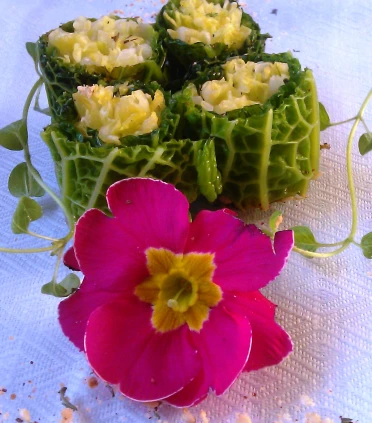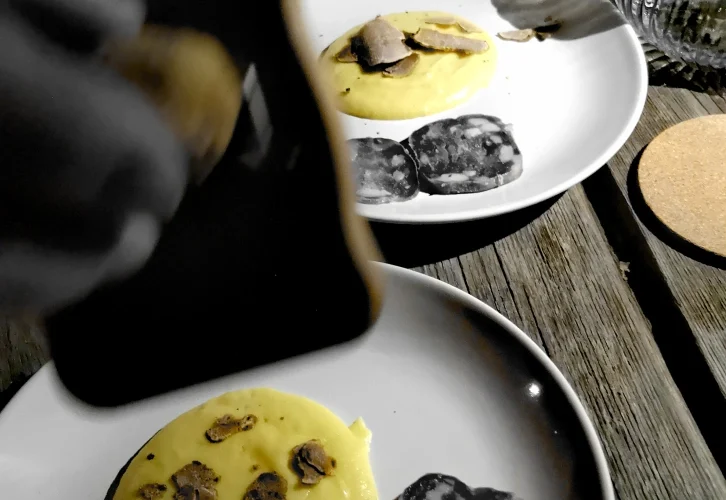
WHITE TRUFFLES & TOPINAMBUR: Jerusalem Artichokes on Fonduta with Crushed Hazelnuts & Truffle Salt
faustina_g
- May 4, 2024
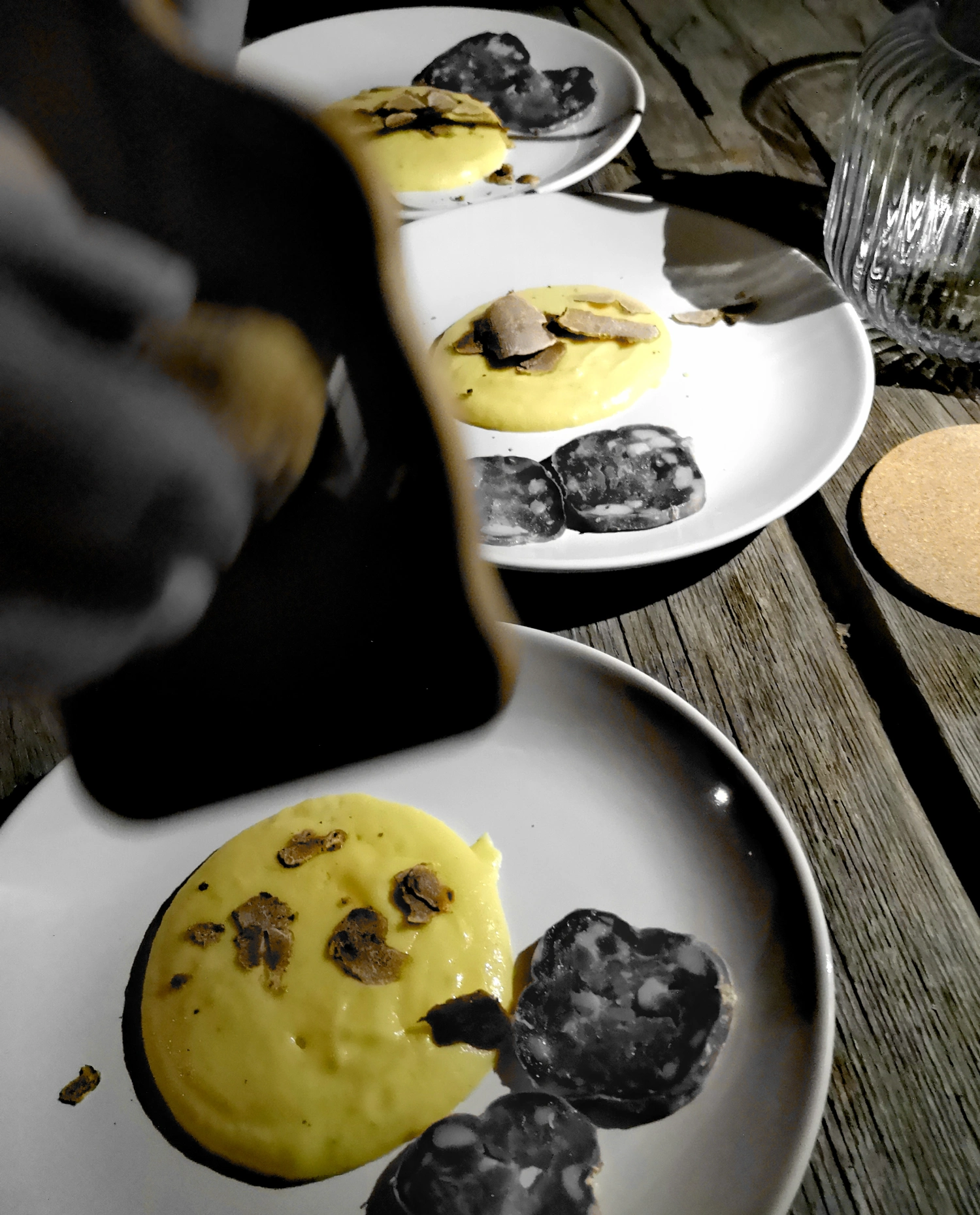
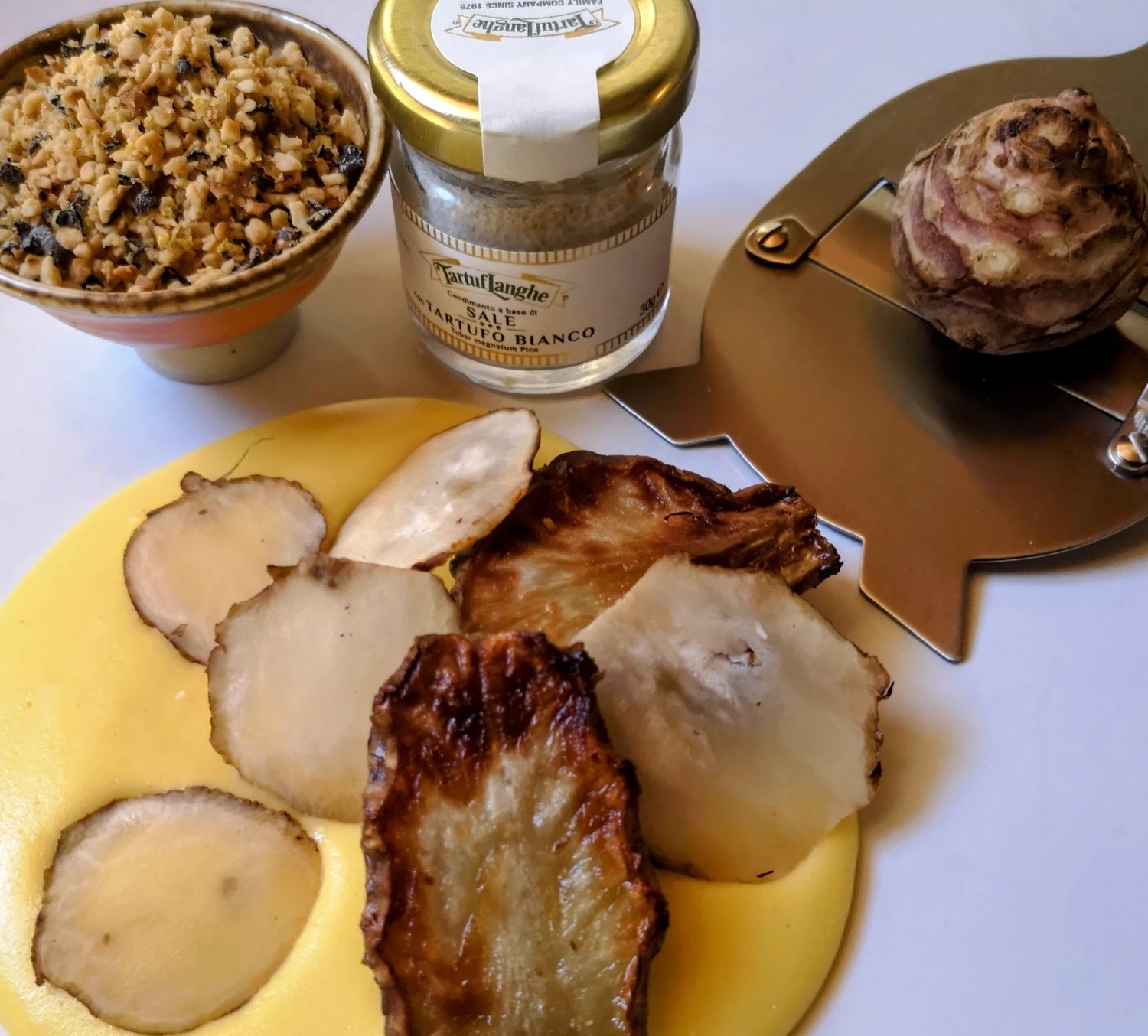
Early autumn mornings were unnaturally quiet for me this year in the Alta Langhe.
They lacked those sudden pistol-like cracks echoing through the silent, misty pre-dawn – not actually gunfire as I had initially thought (well, everything is exaggerated at 4.00am in the morning!) – but nutshells being smashed and shattered on the stone path outside my bedroom window.
Grunting, snuffling and the shuffling of feet through dead leaves would then follow… …. ah, wild boar I had thought….but no, when I peeked cautiously through the curtains, I could make out the outline of a shadowy badger munching contentedly on a breakfast of fresh hazelnuts. Although earthworms and insects are their staple food, I can imagine how any nuts or fruit strewn in their path would make a badger very happy.
I had named him Signor Tasso – being the Italian word for badger – and found his daily presence oddly comforting and calming….as if everything was good in the world. But now he seems to have gone and I miss his morning visits!

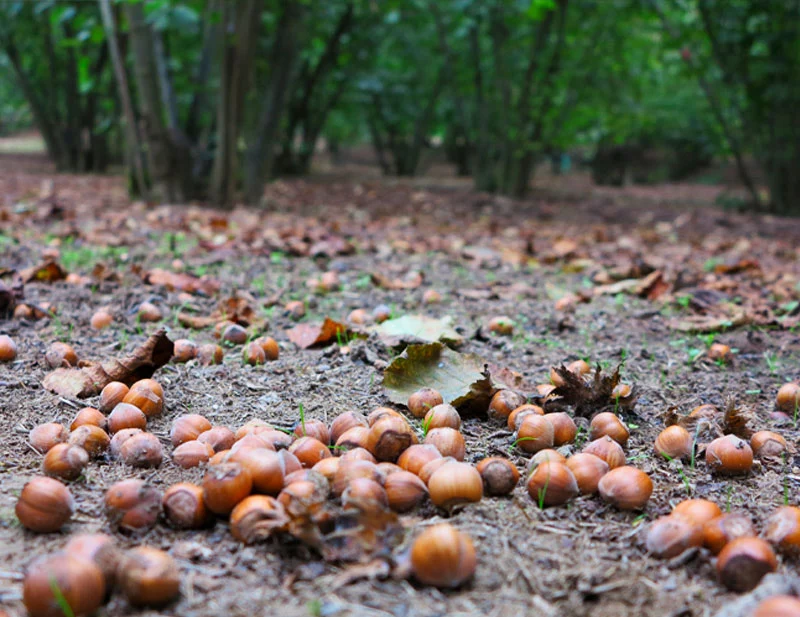
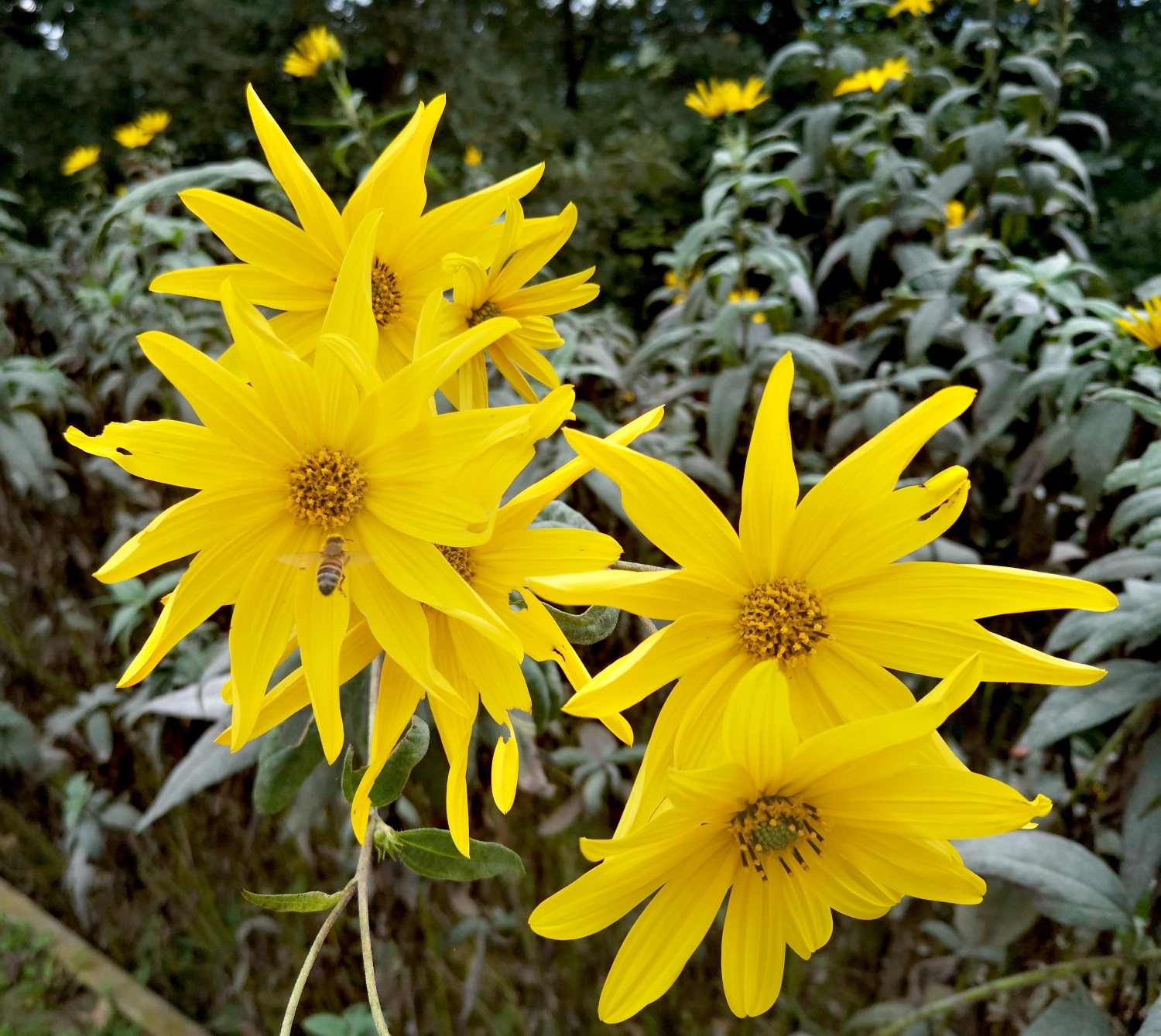
..”he [badger] seemed, by all accounts, to be such an important personage and, though rarely visible, to make his unseen influence felt by everybody about the place”.. (Kenneth Grahame)
I just hope he’s either moved home or passed away peacefully from old age rather than being mauled by a cinghiale or wild boar…or, perhaps more likely, one of the ever-encroaching wolves that were re-introduced into the nearby mountains recently – much to the consternation of the locals and the local pastori or shepherds.
This October I sat out on the balcony in the dark before going to bed still hoping to hear the odd snuffle or grunt….but sadly nothing. Well, nothing on the badger front that is. Elsewhere it was quite busy……. the haunting call of owls echoing through the night air, the strange barking noises of the daino or fallow deer, a lone rattling call from a distant nightjar and countless rustlings in the nearby undergrowth. But no badger.
I’ve always enjoyed sitting quietly outside at night …..I remember in June last year having a nightcap on the balcony when suddenly before our eyes appeared a spectacular light-show of hundreds of fireflies flitting and twinkling amongst the trees and pathways below the house….the avenue of delicate lights they wove was truly magical and something I will always remember.

So even in the early mornings and evenings, exciting things can happen here in the rural Langhe!…. but perhaps none more so than the hugely secretive truffle hunting that is done under-cover of darkness. It was early days for buying truffles being only the beginning of October, but who knows, perhaps there was a chance to find a lucky truffle hunter and his dog?
Well it so happened there was…and thanks to my brother’s efforts and cooking skills, we ended up having a truly unforgettable truffle evening.
It began with a brief phone-call ….a hastily arranged meeting after dark. …the hunter’s proud unveiling of the fresh truffles….a quick check on the weighing scales …a handshake to clinch the price ……a furtive exchange of a small wrapped parcel….and we finally had our first white truffles of the season!
It felt like being in a reality TV drug-deal – without the drugs – but where the real star was the adorable truffle dog!
… have a quick read of the history of these Langotto Romagnolo truffle dogs: http://www.lagottoromagnoloclubofgb.co.uk/the-breed/history-of-the-lagotto/
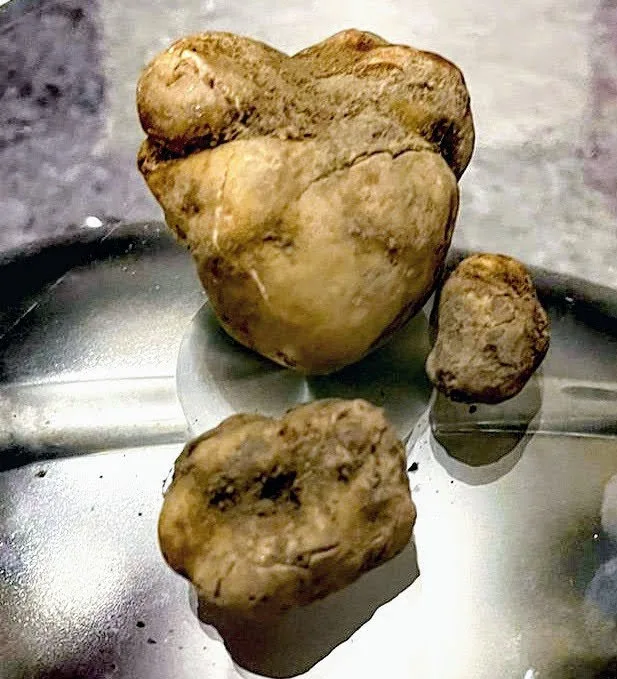

Back at the house, a delicious fonduta was expertly whipped up and served outside by candlelight against the magnificent mountain backdrop of Monviso. One of the prize truffles was passed round for sniffing (in the wine-tasting style) before being reverently shaved over each plate. It was the stuff and taste of dreams!
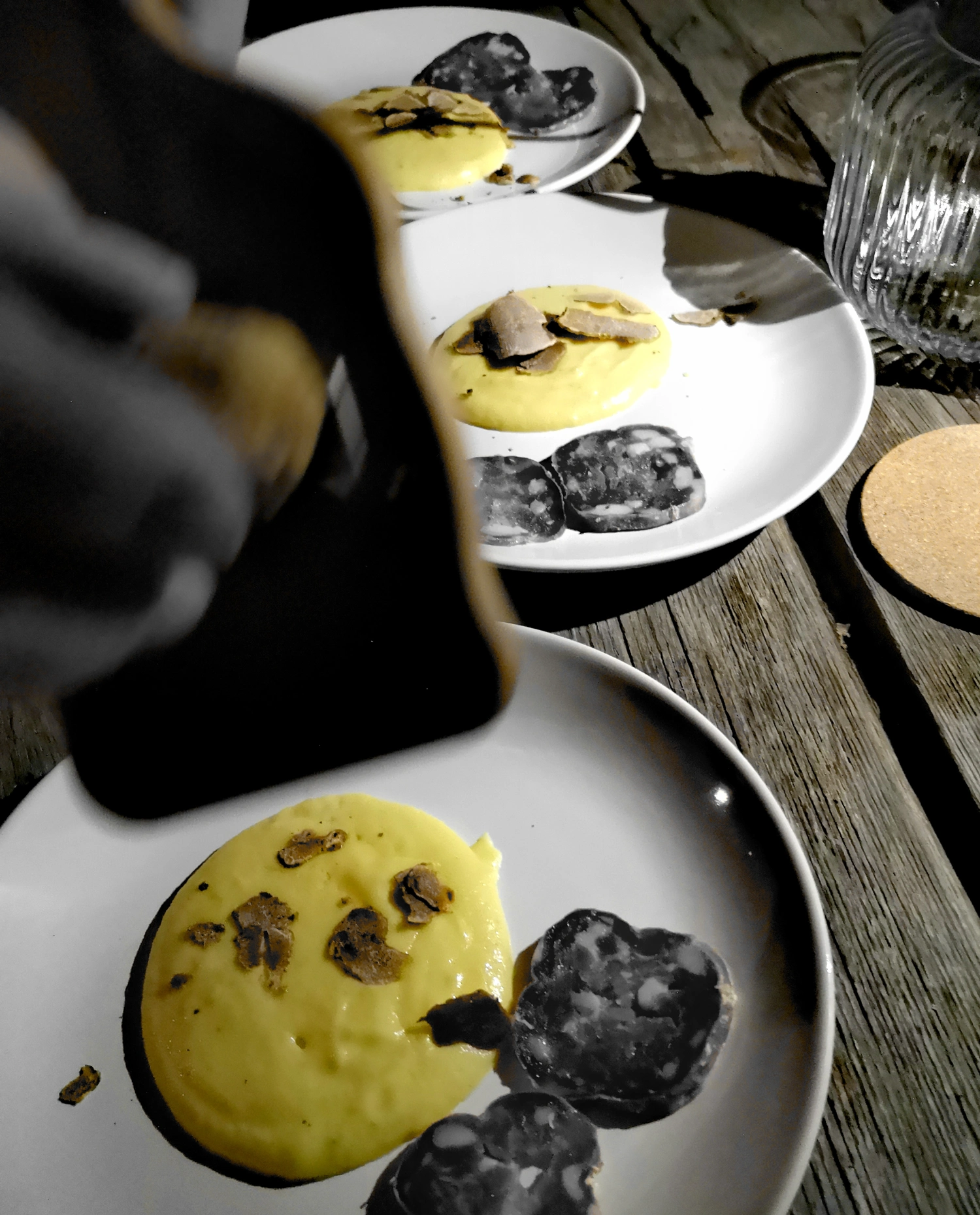

The recipe below is inspired by this simple yet luxurious meal, but because it’s impossible for most of us to find and buy white truffles, I’m using Jerusalem artichokes.
I thought they made the perfect substitution because of their close resemblance to truffles….and although they lack that very particular and addictive aroma that only a truffle can have, they do compensate with a delicious earthy, yet delicate flavor.
They’re also in season at the moment and can be found locally in all the farmers’ markets and food stores.
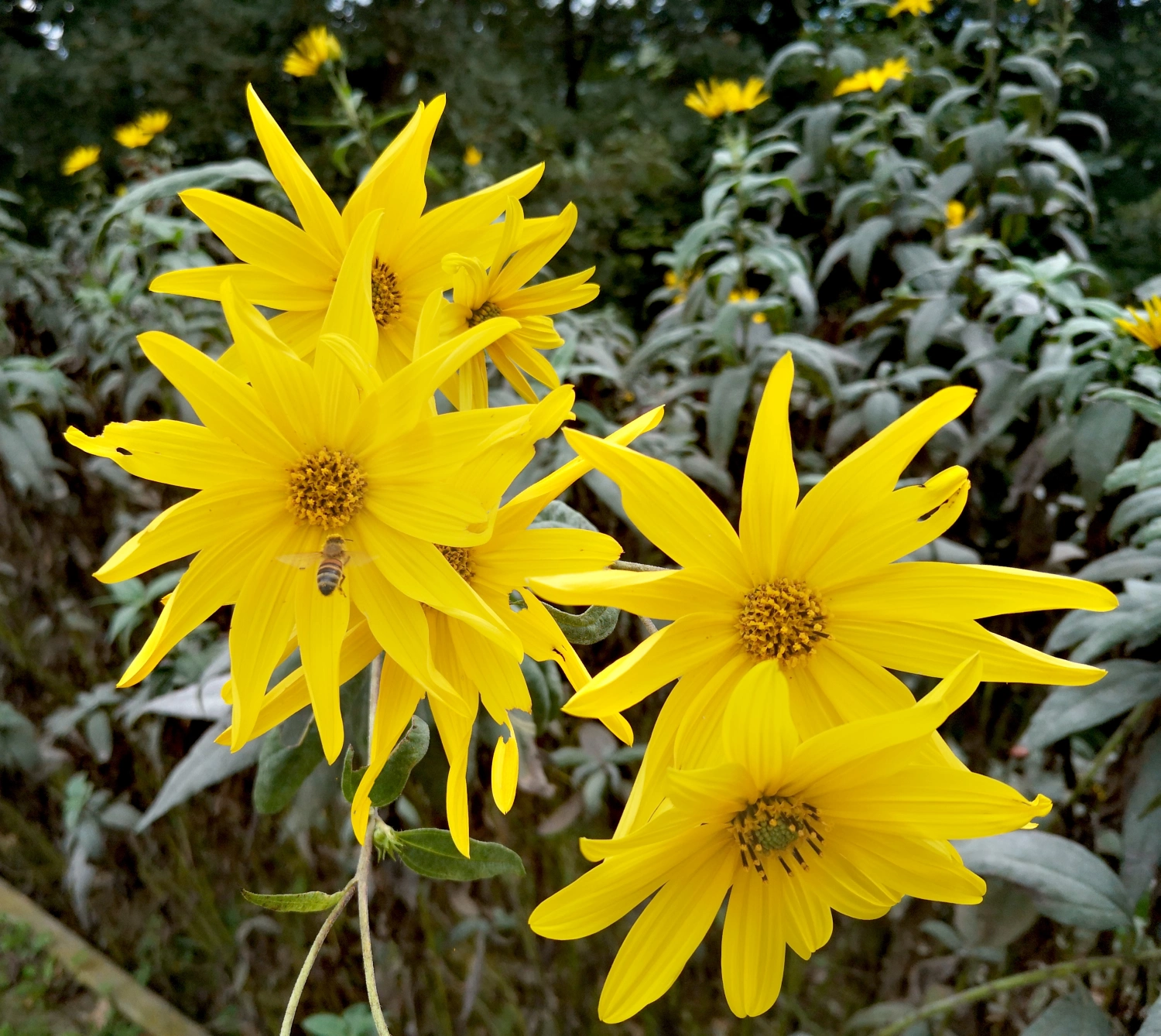
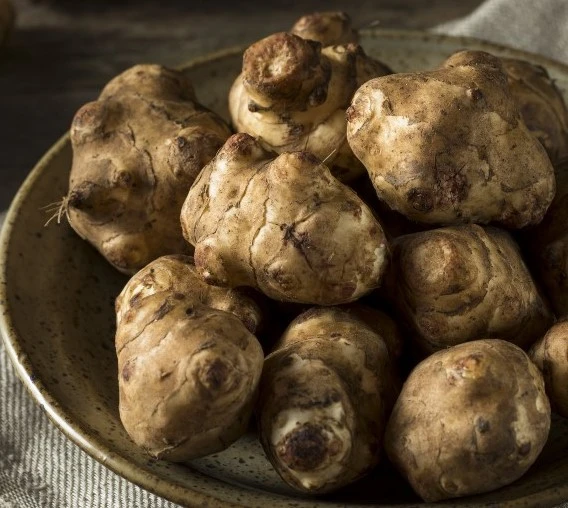
For some background information, Jerusalem artichokes (helianthus tuberosus) are classified as an edible tuber as opposed to the ‘tuber magnatum’ or white truffle… which is actually a mushroom!
Jersualem artichokes have a rather confused history….they are nothing to do with Jerusalem nor are they artichokes, but are part of the Sunflower family. They’re native to North America and were cultivated there for centuries where they were called variously sunroots, sunchokes, wild sunflower and earth apple.
So why and how did the name Jerusalem happen?….
Well a popular story goes that when sunchokes arrived here in Italy – sometime in the 17th century – they were thought to be sunflowers because of their yellow flowers and were thus named ‘girasole’ (sunflower in Italian). Then apparently, some hapless English speakers mispronounced the Italian ‘girasole’ and the word morphed into ‘jerusalem’.
Possibly, who knows!….however, Jerusalem artichokes have their own name in Italy and are called topinambur from the original French word ‘topinambour’.
So why this name you might ask?!
It was the Swedish naturalist Carl Nilsson Linnaeus (1707 -1778) who named the plant ‘topinambur’. Linnaeus famously devised a system for classifying plants and when he received some sunchoke samples from North America to identify …….’he decided to name the plant after the ‘Tupinamba’, a Brazilian tribe who apparently had never eaten the root (they were cannibals) but happened to be visiting the French Royal court (at gun point) at around the time the (sunchoke) samples arrived’.. (Andy @ siteaboutnothing.net)
…..rather a random connection, but somehow the name stuck anyway!
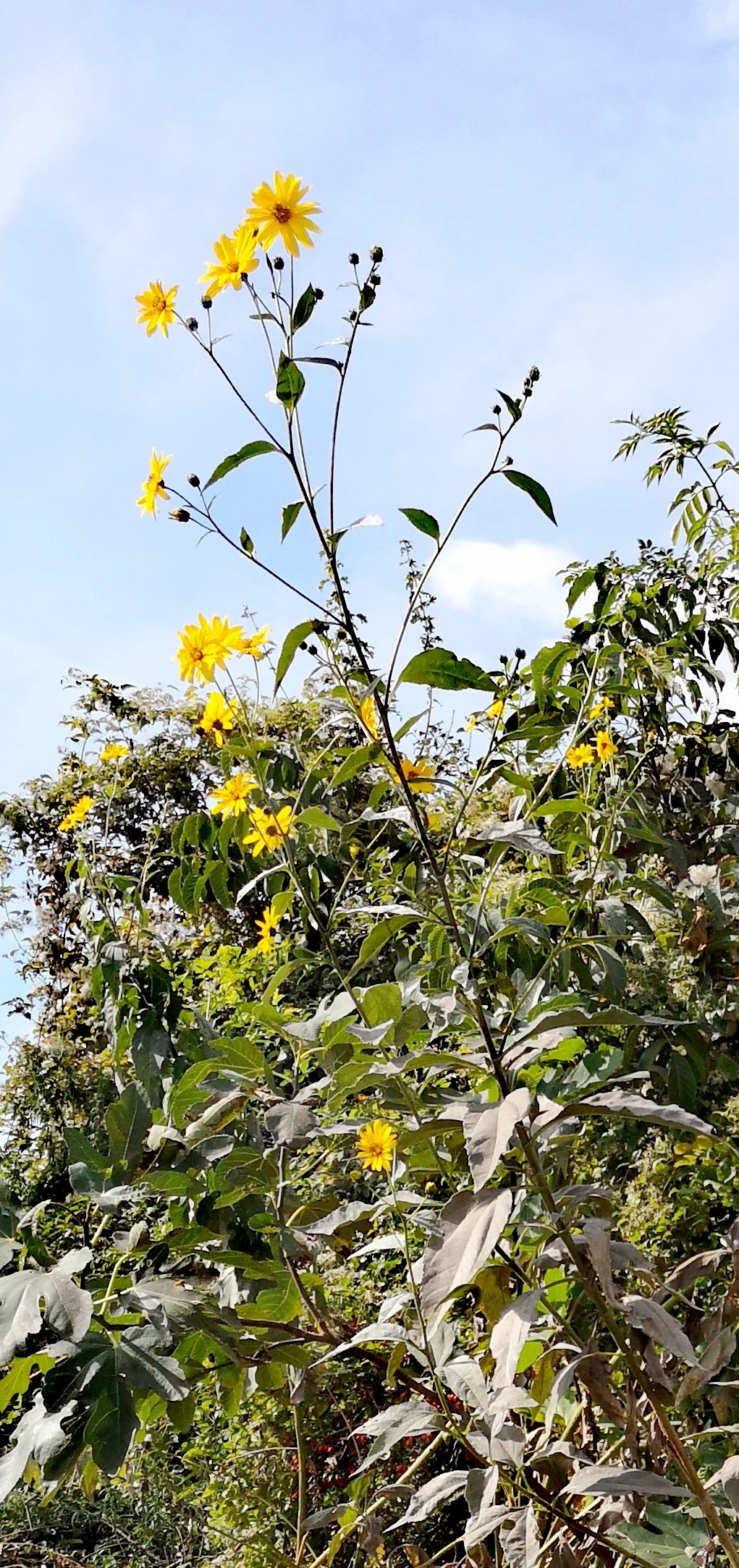
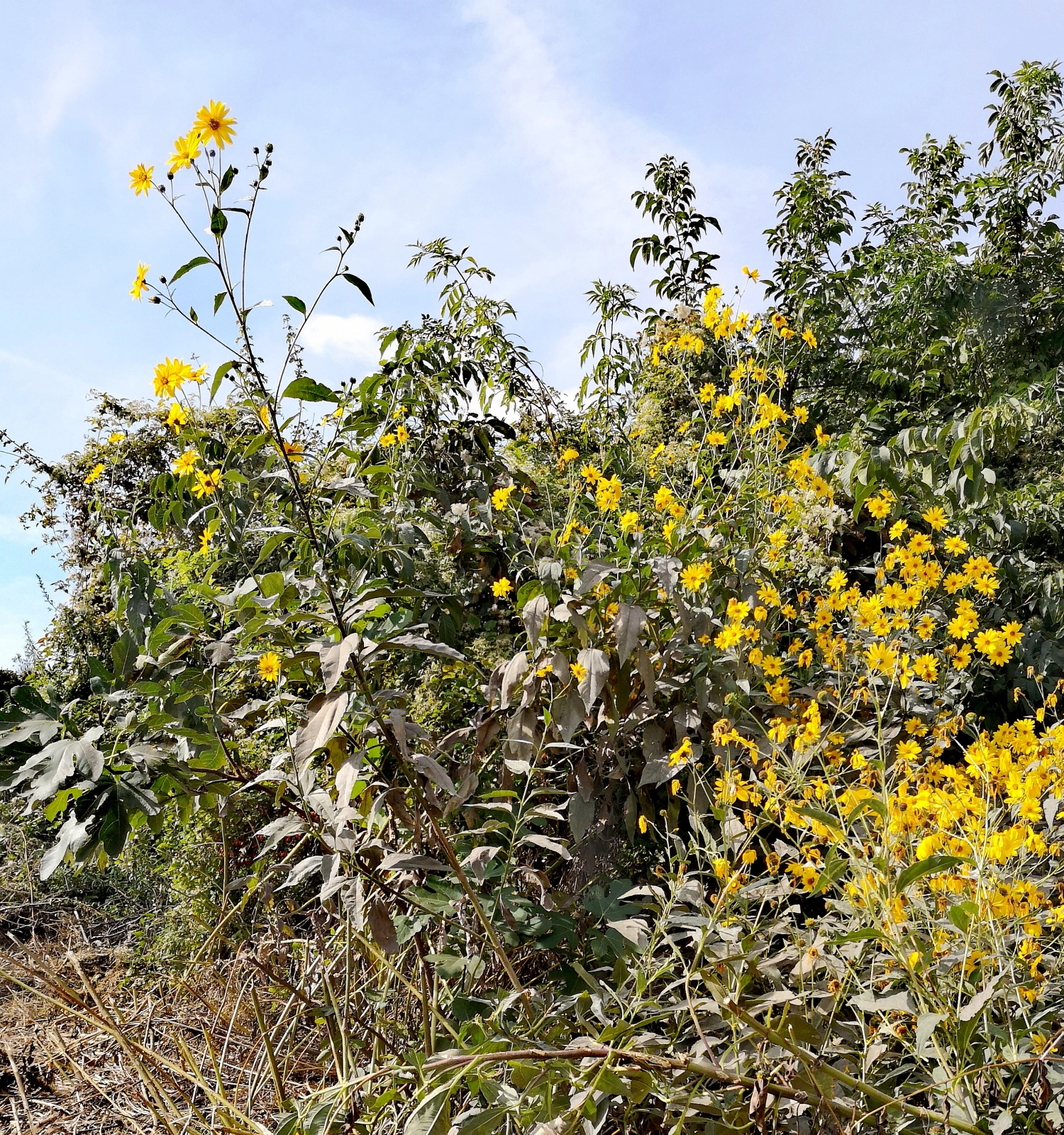
The actual topinambur plants with their vibrant yellow flowers can grow up to 10 feet tall and are a favourite for birds – particularly migrating birds – who love to perch on top to rest and get …..well, a birds’eye view of the surrounding land!
The edible tubers below are full of health benefits – they’re rich in B, C and D vitamins as well as potassium, iron and copper, are low in starch and are particularly known for having ‘inulin fibre’ (a soluble fibre found in many plants). This fibre helps to promote a robust digestive system and to strengthen the immune system.
The one possible and slightly ‘uncomfortable’ side-effect from eating topinamburs can be wind or gas….’fartichoke’ is yet another name for these tubers! If you haven’t ever tried them before I suggest taking it gently. Some people can be more sensitive to them than others, so you might want to just try a small bit and gradually increase the amount over time.
The famous French chef and restaurateur, Auguste Escoffier had a recipe for ‘Puree Palestine’ which used 800g of Jerusalem artichokes – and although I’m sure it was delicious (Jerusalem artichoke soup really is delicious)…. I imagine it might have caused quite a ‘stir’ in polite eating circles!
RECIPE: Roasted Jerusalem Artichoke on Fonduta with Crushed Hazelnuts, Truffle Salt & Shaved Artichoke slices
Similar to the Swiss or French fondue, Italian fonduta differs in that eggs are used instead of flour to thicken the sauce….and no wine, alcohol or garlic is added.
This fonduta recipe is based on a traditional Piemontese recipe and uses Fontina, an aged Alpine cows’ cheese from Valle d’Aosta which has a mild, nutty flavor and is a good melting cheese. If you can’t find Fontina you could always substitute with any good melting cheese…. gruyere, gouda or even parmesan or cheddar.
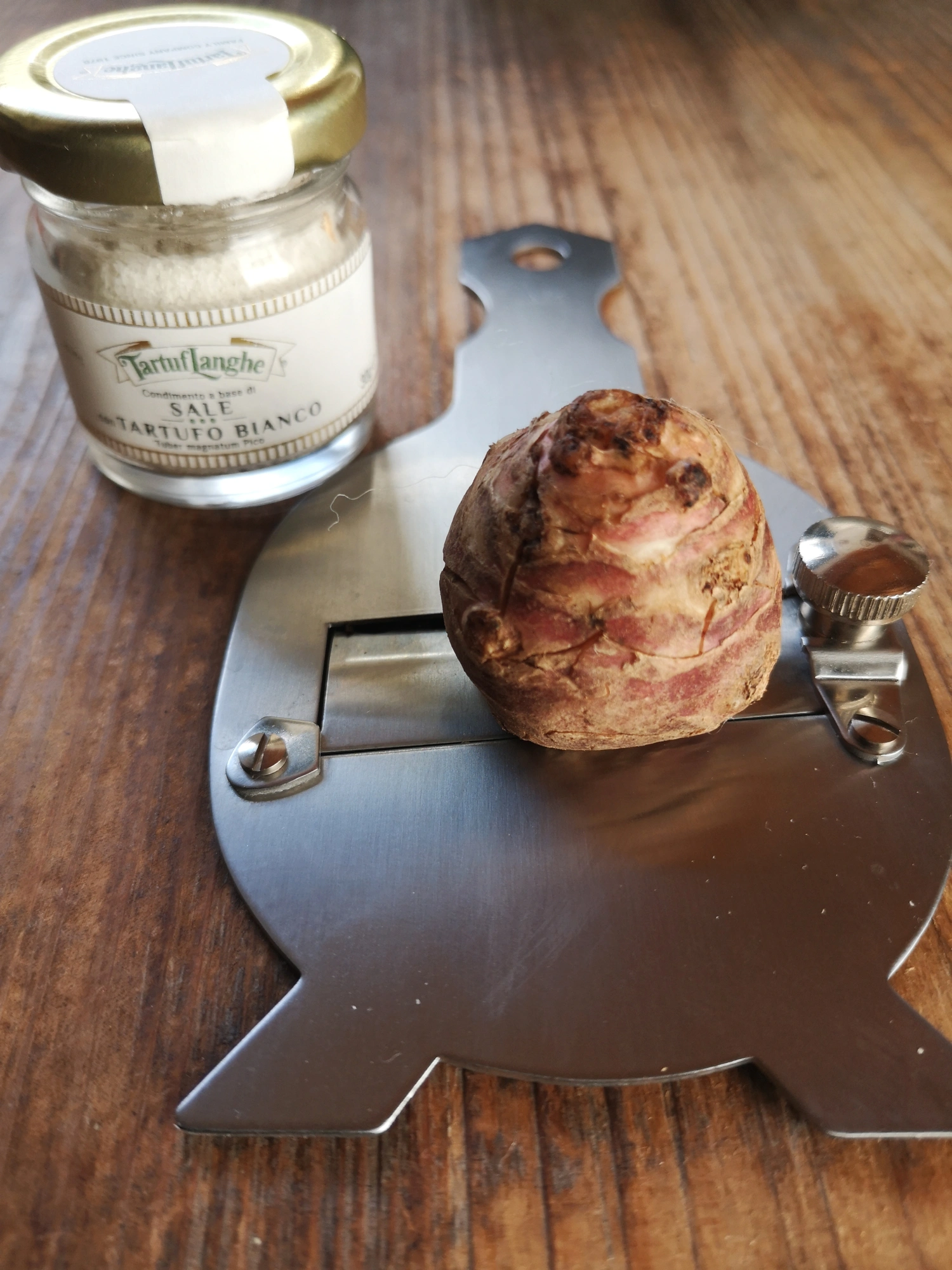
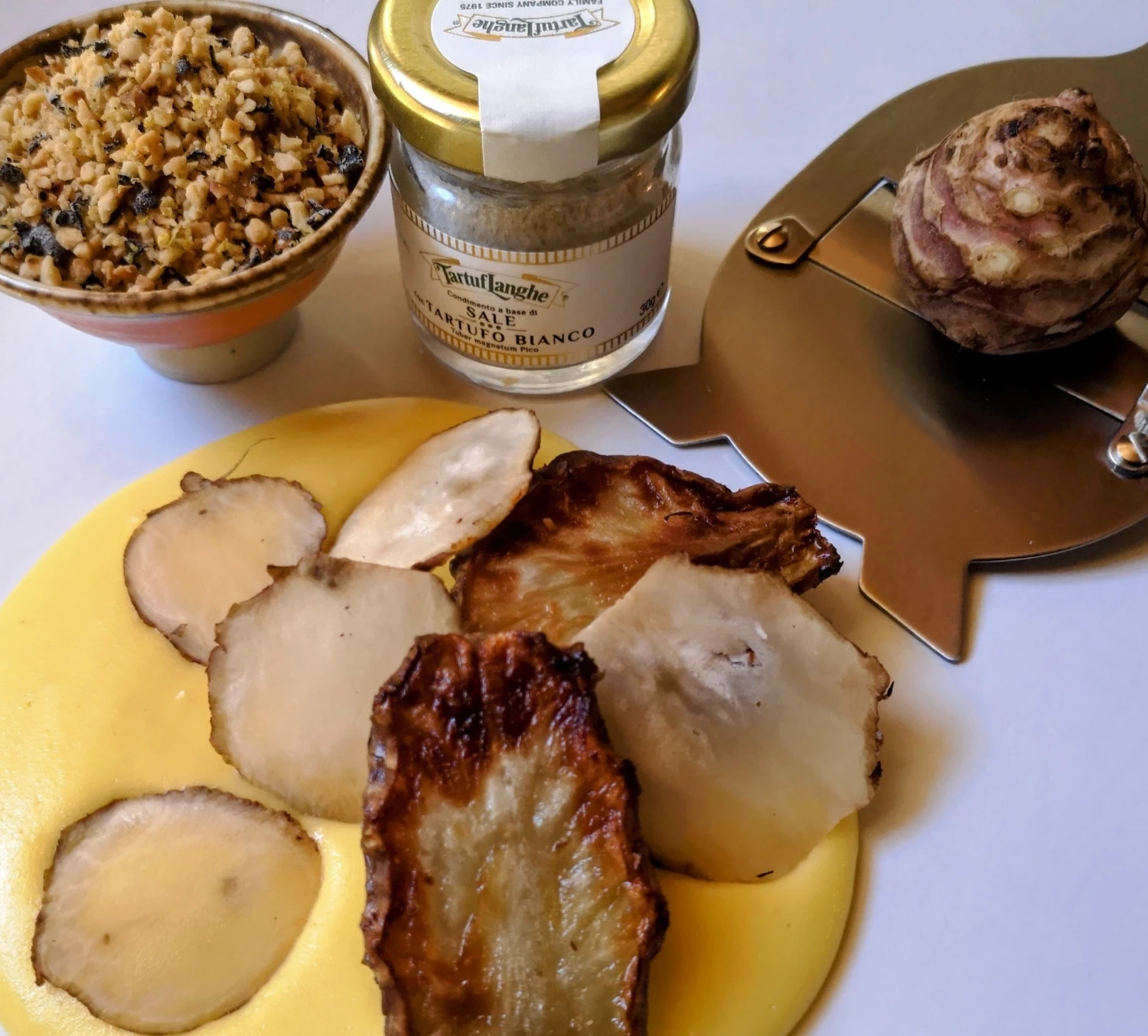
Serves 2
Prep time: 20 minutes
Total time: 35 minutes
Preheat oven to 200C/400F
1. Put the jerusalem artichokes in the oven Roasted & Raw Jersusalem Artichokes
Ingredients
5 Jerusalem artichokes (3 medium-sized and 2 small ones)
3-4 tbsp olive oil
1 tsp ground black pepper
Method
Scrub the artichokes well and put the 2 small ones aside, these will be used for shaving raw over the dish
Halve the 3 medium-sized artichokes lengthwise and place them in a baking dish – cut side down.
Drizzle over the olive oil and sprinkle with ground black pepper.
Roast in the oven for about 35-40 minutes or until fairly soft inside – roast for longer if necessary.
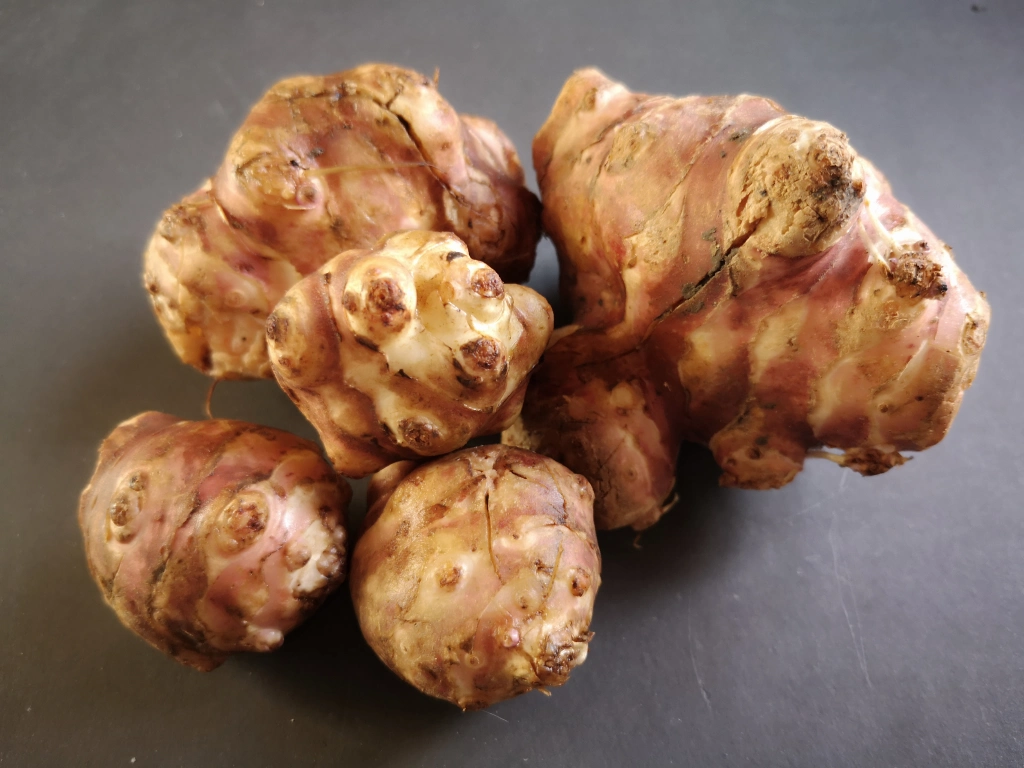
2. Whilst the artichokes are roasting toast the hazelnuts
Crushed Hazelnuts & Truffle Salt Ingredients
3 Tbsp hazelnuts
1½ tbsp finely chopped fresh sage leaves (or parsley if you prefer)
1 Tbsp lemon zest
1 tsp white truffle salt
Method
Lightly toast the hazelnuts in a dry fry-pan and then tip into a small food processor.
Add the chopped sage, lemon zest and truffle salt and pulse until you have a coarse crumb.
Tip into a small bowl for serving
3. Just before you take the artichokes out of the oven, make the Fonduta Fonduta
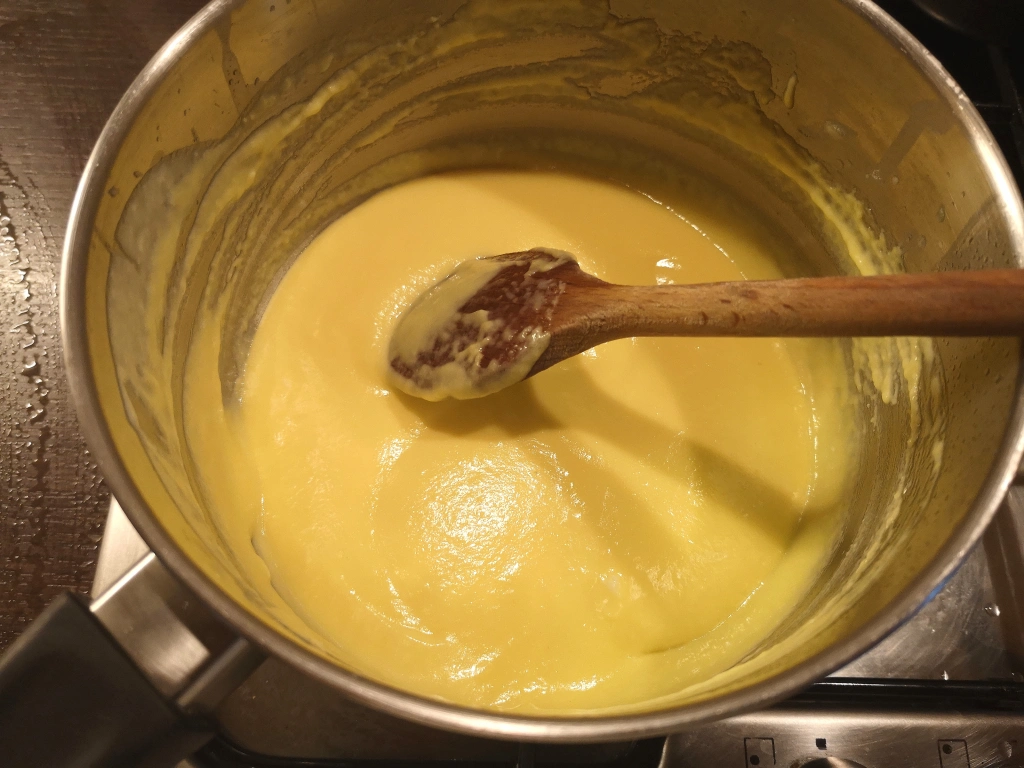
Ingredients
200g fontina cheese, rind removed and grated
120ml milk (+ a little more if needed later)
20g butter
2 egg yolks
** I’m omitting salt as Fontina can be quite salty and also you’re going to be adding truffle salt to serve.
Method
Traditionally, you put the grated fontina cheese and milk into a small bowl, cover and put in the fridge for a couple of hours or ideally overnight. This allows the cheese to plump up and absorb the milk which will help it melt easier.
However, here I put the grated cheese and milk into a bowl and left for just a couple of minutes.
Take a medium-sized saucepan and melt the butter. Then slowly stir in the cheese and milk until the cheese has melted. Keep stirring.
I then swapped to a whisk and added in the egg yolks, one at a time, over a low heat. Keep whisking – for up to 10 minutes if necessary – until the sauce has thickened and is smooth and glossy. Add a bit more milk if it’s getting too thick.
N.B. If you have any difficulty getting a smooth sauce, try stirring in a teaspoon of flour mixed with a tablespoon of milk. Even if it’s not traditional it could smooth things out!
To Serve
Take 2 plates and gently pour or ladle half of the fonduta onto each plate Place 2 or more of the roasted artichoke halves onto the fonduta. Then take one of the small raw artichokes and shave some slices over the top. Sprinkle the dish with a pinch of truffle salt and serve the bowl of crushed hazelnuts on the side to be scattered on top. Leave both the truffle salt and artichoke grater on the table for helping yourselves.
The Truffle salt I’m using is made from white truffle – the famous Piemontese Alba ‘white gold’. White truffles are more delicate than the black and personally are my favourite! If you can’t find truffle salt you could also use truffle oil….or even mushroom salt, which is usually made from dried porcini mushrooms and would make a good substitute.
